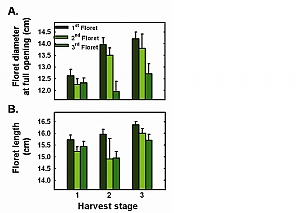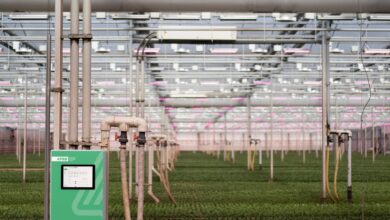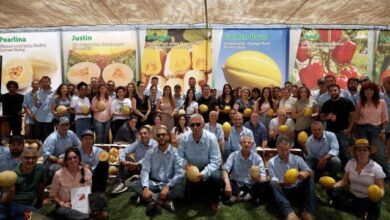Ocean Transport of the Easter Lily: Minimizing Premature Aging
Results of a research on the ocean transport of two strains of lilies, “The White Son” and “Maggie Blanche”
Shimon Meir, et al.

ocean transport of the easter lily (lilium longiflorum): defining the harvesting stage and treating the plant with gibberellins in order to minimize premature aging of leaves
abstract
the current article details the results of a research study on the ocean transport of two strains of lilies, “the white son” and “maggie blanche”, in comparison to transporting them by air, and examines the application of gibberellin ga4+7. findings indicate that, in comparison to air transport, these lilies can be transported by sea with great success, without impairing their quality. the recommended harvesting stage for ocean transport of the lilies is during the initial mounding of the first trumpet, when it reaches a height of at least 11cm and is still green in color, or has just begun to turn white. in addition, the results clearly show that the administration of gibberellin ga4+7 (novagib) at a concentration of 5ppm is even more effective than ga3 (teabag) at a concentration of 25ppm in delaying the aging of the leaves during vase-life, in cases of air and ocean transport of the lilies. accordingly, it is recommended to examine the economic benefits of using the new gibberellin ga4+7, found to be effective in small doses.
introduction
the flowering lily stems are quite large and heavy. therefore, it is most significant to reduce shipping costs by sending the lilies by ocean freight, rather than by air. according to a financial analysis conducted in 2008, the costs of ocean transport in comparison to air transport (marketing and freight), amounted to a savings of 17,000 is per dunam. this is a very significant savings for the grower. as such, reliable methods for shipping lilies by sea must be developed.
flower auctions and direct dealers generally receive the lilies before the flowers begin to bloom. the first trumpet has reached its maximum height and is in a closed position. this stage is also the recommended harvesting stage and the flowers are packaged into cartons for air transport. the recommendations for post-harvest treatment include the administration of preservatives containing 8-hydroxyquinoline citrate and other chemicals (tog-4), in addition to the administration of gibberellin ga3 at a concentration of 25ppm to delay leaf senescence and discoloration. the experiments conducted indicated that sufficient results are obtained by reducing the concentration of ga3 from 100ppm (the previous recommendation) to 25ppm.
chemical compounds and methods
chemical preparations: the following were supplied by “merhav agro”, ashdod: tog-6 containing organic chlorine, tog-4 containing 8-hydroxyquinoline citrate, the “teabag” preparation containing ga3 and “novagib” containing ga4+7.
administration of treatments and shipment simulations: lilies were picked at varying stages (as detailed in illustrations 2-5), sorted and bound together (5 stems per bind), and then brought in cartons to the laboratory at the volcanic center. immediately upon their arrival, the flowering stems were administered with the recommended treatment, comprised of 0.2% tog-4 + gibberellin ga3, given in the form of the “teabag” preparation at concentrations of 25-50ppm. the flowers were then packed into commercial cartons and stored for freight simulations (2-3 days by air and 8 days by sea).
defining the harvesting stage and vase quality measures: two factors served to determine the harvesting stage: the flower dimensions, as detailed in illustration 2b, and the changes of bulb color – from completely green to turning to white (illustration 5g). eight stages of development and aging of the “white son” strain were defined, as detailed in illustration 1. the first and second trumpets, as well as the third in certain trials, were marked and a follow-up of the vase life of the flowers was conducted. the degree of yellowing and aging of the stems were evaluated visually, on a scale of 1-4 (as detailed in illustration 6b), while 1 = no yellowing; 2 = initial yellowing along the bottom leaf; 3 = yellowing on 5-7 lower leaves; 4 = severe yellowing of the lower leaves (about 15 leaves), but the upper leaves are still lovely.
illustration 1:
defining that stages of blooming and aging of the lily trumpets from stage 1 = closed, green and extending to a length of 7-9 cm, through stage 8 = the aging stage.
results and discussion
a. the effect of the harvesting stage on the quality of the flowers following ocean transport in comparison to air transport
the results of the experiments conducted on the “maggie blanche” lily flowers that were picked at three stages (illustration 2g), indicate that ocean transport (illustration 2e) did not affect the number of days (6-7 days) during which the flowers were open in the vase, in comparison to air transport (illustration 2b). in other words, the method of shipment did not influence the pace of aging of the flower from the stage at which it had already opened. the only difference between the two methods of shipment was the pace of blooming (opening), particularly regarding the first trumpet, which was shorter (1-1.5 days less) after being transported by sea (illustration 2d) in comparison to air transport (illustration 2a).
the total number of vase life days for stems picked with the initial trumpet at stage 3 was only one day shorter for the lilies transported by sea (illustration 2f), in comparison to those shipped by air (illustration 2c). this difference stems from the shorter amount of time (one day) before the opening of the second trumpet on a stem that was picked at stage 3 and sent by ocean transport (illustration 2d), in comparison to air transport (illustration 2a).
as mentioned, the flowers shipped by ocean transport bloomed at a similar rate to those that underwent the air transport simulation. the only problem is the pace of the initial bloom and the subsequent danger of numerous stems with trumpets at stage 4a (illustration 1) being presented at the auctions due to their continued development during ocean transport. this could lead to a reduction in the sale price. it was found that the stage of development at harvest time is the factor that causes the trumpets to reach this undesirable stage 4a (illustration 4). of the flowers picked with trumpets at stage 1, (grower c) only 5% reached the undesirable stage, in comparison to 40% and 75% of the flowers picked at stages 2 and 3, respectively. the flowers picked from two other growers (a and b) at stage 1 did not reach the undesirable stage at all (illustration 4). of the flowers picked at stage 2 from growers b and c, only a very small percentage developed at an undesirable pace. since flowers that are picked with trumpets at stage 1 do not open to their full potential (illustration 4), it would appear that stage 2 is the more appropriate harvesting stage for lilies being transported by ocean freight. the difference between the growers indicates that not only does the size of the bulb at harvest time determine the stage of development of the flower after shipment, but another factor does so as well. it is possible that the changing of the color from green to white, resulting from the breakdown of the chlorophyll, might be a more reliable measure for the harvesting stage.
these findings indicate that, in comparison to air transport, lilies can be shipped by ocean freight with great success, without impairing the quality of the flowers, on the condition that the harvesting stage is meticulously monitored. therefore, the recommended harvesting stage for ocean transport is the stage of initial mounding of the first trumpet, when it reaches a height of at least 11 cm. and when its color is still green, or has only just begun to turn white.
b. examining the administration of gibberellins in order to delay the aging of the leaves during vase life
the administration of gibberellin ga3 at a concentration of 25 ppm is generally a sufficient treatment, as long as the treatment is administered properly and the shipment is implemented effectively, logistically as well as the appropriate cooling systems. however, often there are cases of yellowing leaves in the vase while the flowers are still vital and beautiful. results of experiments conducted on the white lily have shown that the use of gibberellin ga4+7 is more effective than ga3 in delaying the aging of leaves.
experiments were conducted on flowers from the “white son” strain to compare the administration of ga4+7 at concentrations of 5, 10 and 25ppm with the administration of ga3 at concentrations of 25 and 50ppm. the results, presented in illustrations 6 and 7, clearly indicate that the administration of ga4+7 at a concentration of 5ppm was more effective than the administration of ga3 at a concentration of 50ppm, following an extensive simulation of air transport that included a two-day period of storage.
illustration 2: the influence of the harvesting stage on the “maggie blanche” lily after being transported by air (a,b,c) and by sea (d,e, f), on the days for opening of flowers 1 and 2 (a,d)
illustration 3: the influence of the harvesting stage on the “maggie blanche” lily, on the diameter (a), the length (b) of trumpets 1-3 at full bloom (stage 7) and during vase life, following the administration of ga3 and a simulated air transport.
illustration 4: the influence of the harvesting stage on lilies with flowers that have begun to bloom (stage 4a in illustration 1).
illustration 5: the influence of the harvesting stage on the days before opening to flowers 1 and 2 (a, d) and on the total vase life.
illustration 7: flowers from the “white son” strain that were treated with some of the treatments detailed in illustration 6, following a simulated air transport and after 14 days in a vase.
 |
 |
.jpg) |
authors:
shimon meir1, shoshana salim1, batina kochank1, tamar tzedaka1, tamar lahav2 and sonia philosof-hadas1
1 department for the research of harvested agricultural produce, agricultural research center, volcanic institute, beit dagan; 2 training and occupation services
shimonm@volcani.agri.gov.il
(published in israel agriculture, 2011)




